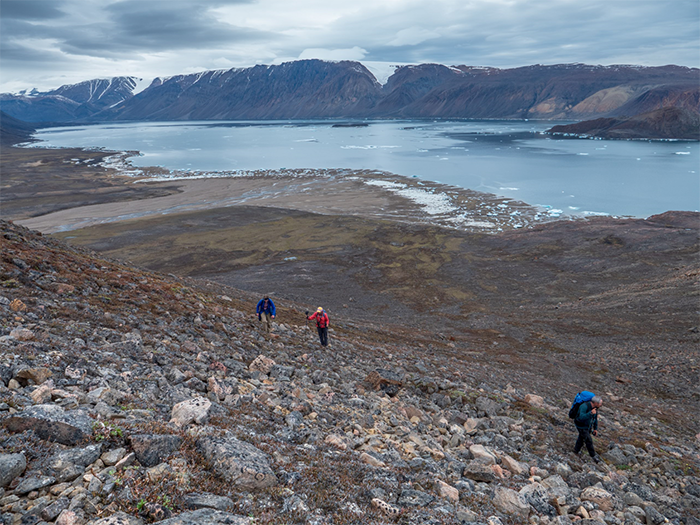Dickinson College's Arctic Studies Program Celebrates Milestone

Baffin Island, 2013. Photo by John Pohl ’78, P’06.
Permanent funding, endowed chair expand student-research opportunities
by MaryAlice Bitts-Jackson
If you’ve never camped out on an ice-crusted ocean, scaled a glacier or sighted a polar bear in the wild, then you can’t truly grasp just how fierce and fragile the Arctic and polar regions are. No book or documentary can quite prepare you for the scale and majesty you’ll discover there. And once you experience it, you’ll be better able to understand it and why it’s so important to protect.
Seven years ago, Dickinson launched the first of 11 student-faculty research trips to the Arctic and polar regions, providing a chance for students to not only experience the vast and largely unspoiled lands but also contribute to our understanding of them. Now, Dickinson’s Arctic-studies program takes an important next step, with a faculty chair and dedicated coursework and fieldwork.
The funding is spearheaded by Susan Wyckoff Pohl ’80, P’06, a former Dickinson Board of Trustees member with a vision for experiential education at her alma mater, and husband John ’78, P’06, who studied political science and geology at Dickinson. Collaborating with John’s contacts in the earth-sciences department, they hosted the first research trip in 2013 to Arctic Canada. During the following three years, students and faculty traveled with the Pohls to Greenland, Iceland, Alaska and Canada to conduct original research on the effects of climate change, measuring sea-ice thickness, using GPS to document glacier sizes and flying drones to map volcanoes.
This is not for the fainthearted. Student- and faculty-researchers travel to the High Arctic in float or tundra-equipped aircraft and then hike, raft or kayak to even more remote areas to collect samples and data. They camp out—in some instances, directly on the ice. They plan their packing lists carefully, as they need to adapt to fast-changing weather conditions and also need to carry instruments and samples. For up to 12 days, they have no cellphone coverage—their only tool to communicate with those outside their party is an emergency satellite phone.

The High Arctic. Photo by John Pohl ’78, P’06.
These conditions help students sharpen collaboration and problem-solving skills. Students taking part in the program also report deeper understanding, and in some cases, deeper engagement with environmental issues. Some, like four-time Arctic-trip veteran Will Kochtitzky ’16, go on to pursue related careers.
"We don’t fully understand what impacts our actions have on the planet and how the planet is responding,” says Kochtitzky, a Ph.D. student at the University of Ottawa. “These programs are critical at Dickinson because both giving the students the skills to understand ways to quantify the impacts of climate change and bringing them on once in a lifetime trips inspires them to continue in STEM fields, and helps improve how our global community understands climate change.”
Recognizing the ripple effects of this work—both on the students, who gained valuable fieldwork and research skills, published original research and presented at national conferences, and, potentially, on climate science and society at large—Dickinson expanded the program in 2017 with alumni support. Beginning that year, the college offered two Arctic student-faculty trips each summer—an expensive endeavor, despite the roughing-it conditions, in part because the aircraft carrying researchers and others to these remote areas are small and in high demand.

Alexandra Fjord. Photo by John Pohl ’78, P’06.
Four years later, the program marks another milestone. Established this year, the Moraine Chair and Pohl(ar) Expedition Fund, spearheaded by the Pohls, supports fieldwork and Arctic-studies courses and establishes an endowed faculty chair to run the growing program. The program also is establishing connections with the Smithsonian Museum of Natural History Arctic Studies Center and the University of Ottawa’s glaciology research group and is deepening connections with the University of Maine Climate Change Institute.
“What’s exciting is that in just seven years, we’ve gone from taking a couple of students along with us for a research trip with alums to a robust program that deals with critical issues,” says Professor of Earth Sciences Ben Edwards, who’s led Dickinson’s arctic fieldwork trips since 2014 and is the first faculty chair.
The new program features pave the way for interdisciplinary Arctic research. Students majoring in the social sciences, for example, could have an opportunity to perform original research in the Arctic that brings them in touch with indigenous people—such as the Inuit guide who led a past student-faculty team safely across the ice and provided valuable insight on climate change from the Inuit point of view, or the mayor of Grise Fiord, the northernmost community in Canada, who joined the students for dinner one evening on a 2019 trip.
While the summer 2020 student-faculty trip to Svalbard was canceled because of the pandemic, Edwards and Kochtitzky led a virtual two-week course for students interested in the work, including an incoming first-year. Using high-tech GIS technology, satellite images and aerial photos, and with guidance from University of Ottawa Professor Luke Copland, they explored Canadian glaciers and measured the effects of climate change over decades.
“You hear a lot on the news about the Arctic, because there are a lot of countries and organizations that are interested in using its natural resources and waterways, so this work is important and timely,” says Edwards. “And we’re absolutely ahead of the game in this. This program is very distinctive among undergraduate institutions.”
To learn more about Dickinson Arctic research expeditions, visit the new Arctic and Alpine Climate Change Research program page.
You can also see select photos from Arctic research trips to Alexandra Fjord, Greenland, Bylot Baffin and the Gates of the Arctic and more on John's geophotography site.
TAKE THE NEXT STEPS
Published August 20, 2020